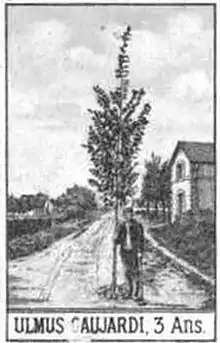Ulmus × hollandica 'Gaujardii'
The hybrid elm cultivar Ulmus × hollandica 'Gaujardii', one of a number of cultivars arising from the crossing of Wych Elm U. glabra with Field Elm U. minor, was raised by the Gaujard-Rome nursery of Châteauroux, France, in the 1890s as Ulmus Gaujardii and was described in the 1898 Kew Bulletin and Wiener illustrirte Garten-Zeitung.[1][2] It won first prize in the International Horticultural Exhibition in Saint Petersburg, Russia, in 1899 and a silver medal in the Heemstede Exhibition, The Netherlands, in 1925.[3] From the early 20th century it was distributed by the Späth nursery of Berlin as Ulmus montana Gaujardi,[4] and in the interwar years by the Boccard nursery of Geneva as Ulmus campestris Gaujardi.[5] It appeared in Unsere Freiland-Laubgehölze in 1913, but without description.[6][7]
| Ulmus × hollandica 'Gaujardii' | |
|---|---|
 'Gaujardii' at 3 years | |
| Hybrid parentage | U. glabra × U. minor |
| Cultivar | 'Gaujardii' |
| Origin | France |
Description
A tree of symmetrical upright growth and of great vigour, with the appearance of an arrow. The foliage was of medium size, oval and light green.[1][2] Four photographs of 'Gaujardii' appear in Pépinières Gaujard-Rome et Cie (1930), where the nursery distinguished between medium- and large-leaved forms.[3] Herbarium specimens suggest that more than one clone has been labelled 'Gaujardii' (see 'External links').
Pests and diseases
Elms of the U. × hollandica group are susceptible to Dutch elm disease.
Cultivation
'Gaujardii' was produced at a rate of 30,000 trees per annum by 1930,[3] though no specimens are known to survive. There was a specimen at Arnold Arboretum, Massachusetts, in the mid-20th century (see 'External links').
Putative specimen
An old U. × hollandica with leaves (unusually for this group) light green all summer and matching the 'Gaujardii' herbarium specimen in The Hague,[8] stands (2019) by 35 Inverleith Terrace, Edinburgh, near the entrance to Royal Botanic Garden.[9] An early 20th century photograph shows it fastigiate when young.[10] Its leaf-shape, samarae, and light suckering confirm its hybridity.
 Inverleith Terrace elm, Edinburgh (2016)
Inverleith Terrace elm, Edinburgh (2016)
References
- "New garden plants of the year 1898". Kew Bulletin. 12–13: 53. 1899.
- "Miscellen". Wiener illustrirte Garten-Zeitung. 23: 27. 1898.
- Pépinières Gaujard-Rome et Cie - 1930. Gaujard-Rome, Châteauroux. 1930. pp. 85, 88, 93, 95.
- Späth, L., Catalogue 130 (1908-09; Berlin), p.137
- Catalogue générale, automne 1936 – printemps 1937, Pépinières Boccard Frères, Geneva, 1936, p.30
- von Silva-Tarouca, Ernst Emanuel (1913). Unsere Freiland-Laubgehölze. p. 366.
- Green, Peter Shaw (1964). "Registration of cultivar names in Ulmus". Arnoldia. Arnold Arboretum, Harvard University. 24 (6–8): 41–80. Retrieved 16 February 2017.
- bioportal.naturalis.nl, specimen WAG.1847162
- Google Maps: Inverleith Terrace - Google Maps (May 2018), accessdate: August 13, 2019
- edinphoto.org.uk, 35 Inverleith Terrace, Edinburgh
External links
- "Herbarium specimen - WAG.1847161". Botany catalogues. Naturalis Biodiversity Center. Sheet labelled Ulmus Gaujardi (undated)
- "Herbarium specimen - WAG.1911553". Botany catalogues. Naturalis Biodiversity Center. Sheet labelled U. × hollandica 'Gaujardii', Arnold Arboretum (1960)
- "Herbarium specimen - WAG.L.1587049". Botany catalogues. Naturalis Biodiversity Center. Sheet labelled U. × hollandica 'Gaujardii', Arnold Arboretum (1960); long shoots
- "Herbarium specimen - L.1587054". Botany catalogues. Naturalis Biodiversity Center. Sheet labelled U. hollandica Miller 'Gaujardii', Arnold Arboretum (1930)
- "Herbarium specimen - WAG.1847162". Botany catalogues. Naturalis Biodiversity Center. Sheet labelled U. × hollandica 'Gaujardii', The Hague (1932)